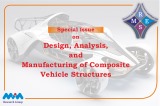Research Article
Tensile and charpy impact properties of CNTs integrated PET/ Glass Fiber thermoplastic composites with commingled yarn
Özgür Demircan1,2, Sarah Sufyan2, Ahmed Mohamed Basem2
1Department of Metallurgical and Material Engineering, Ondokuz Mayıs University, Samsun, Turkey
2Department of Nanoscience and Nanotechnology, Ondokuz Mayıs University, Samsun, Turkey
Keywords
Abstract
Carbon nanotubes (CNTs);
Non-crimp fabric (NCF);
Glass fibre (GF);
Polyethylene terephthalate (PET);
Composite materials;
Tensile;
Charpy impact properties
Within this study, the non-crimp fabrics (NCF) with commingled yarns that they contained hybrid structures in which two different materials in the form of fibers were mixed, which consisted of polyethylene terephthalate (PET)/glass fiber (GF), were coated with multi-walled carbon nanotubes (MWCNTs) (weight percentages were 0 and 0.9%) and modified multi-walled carbon nanotubes (MWCNTs-Carboxylic acid (COOH)) (weight percentages were 0 and 0.9%) to fabricate hybrid composites. Three types of composite materials were prepared (pure polyethylene terephthalate/glass fiber (PET/GF), PET/GF with MWCNTs and PET/GF with MWCNTs-COOH) and they were tested against tensile and Charpy impact loadings. The effects of MWCNTs contents on the micro-structure and morphology of the composites were reported by using a scanning electron microscope (SEM), fourier transform infrared spectroscopy analysis (FTIR) and optical microscopy (OM). The specimens with MWCNTs-COOH exhibited an enhancement of 33% tensile strength, 23% tensile modulus and 8% Charpy impact energy compared to the samples without MWCNTs-COOH. It can be concluded that even a small mass fraction of MWCNTs was capable of improving the mechanical performance of the glass fiber reinforced PET matrix composites. In other words, due to the presence of the carbon nanotubes on the fiber surface helped to improve interfacial adhesion in the fabricated composites.
© 2022 MIM Research Group. All rights reserved.


